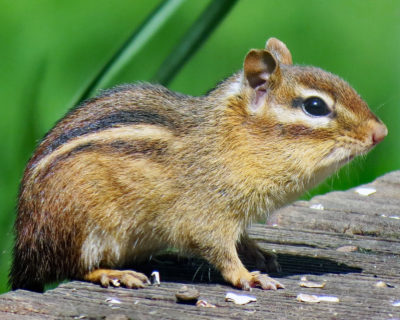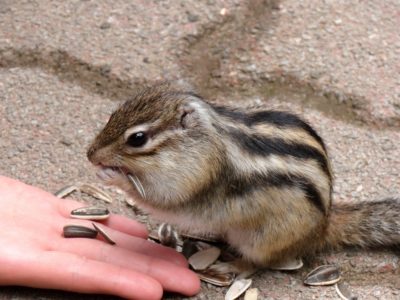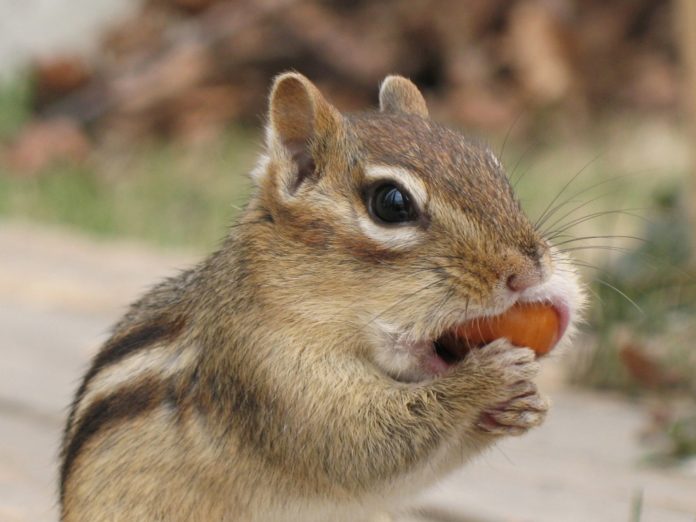With those enchanting big eyes, striped back, chubby cheeks and bushy tail, chipmunks make one of the most adorable rodents. You have probably seen them running around your yard or the nearby woodlands. If not, you’ve definitely been introduced to them by Walt Disney’s chipmunk movie – Chip and Dale. Well, here we will tell you if you can pet a chipmunk or not and what are the measures to take.
Table of Contents
Know your chipmunks
Chipmunks or tamias are known as the ‘storer’. They are a rodent type related to squirrel family. You can identify them by seeing their small stature. Chipmunks are smaller than the average squirrels but bigger than a mouse. They have striped backs and dark eyes; the fat cheeks and lush tail add to their cuteness. You will find them darting around the sidewalks and lawns scavenging for food that they store in underground burrows. During winters, they enter a hibernation state and wake up only to eat the food they store.
Types of chipmunk
Like most species, there are types of chipmunks as well. These depend on the area they populate. Check out the types you can find around the world:
Eastern chipmunk
If you’re from the eastern US or southeast Canada, you have probably seen eastern chipmunks. They are 5-6 inches long but can grow up to 11 inches. They weigh around 2.5 to 4.5 ounces and have brownish red coat. These animals have a couple of white stripes below and above the eyes, and white or brown stripes down the backs. These chipmunks inhabit deep forests but often live in the suburban or rural areas.

Least chipmunk
The least chipmunks are Tamias minimus and smaller in size compared to the eastern chipmunks. They are found across North America and some western states. They are also common in western Canada, Michigan, Minnesota, and Wisconsin. The species are around 7.2 – 8.5 inches tall and weighs around 1.1 – 1.8 ounces. You can find them in open areas, forests, or near water bodies.

Others
Palmer’s chipmunk is an endangered chipmunk species that is found in Nevada and Las Vegas. Their population is being monitored.
There are 20 more species of chipmunks and one of the noted ones are yellow-pine and red-tailed chipmunks. These are also found around the western states. Another popular type is Townsend’s chipmunk that only belong to the extreme southwestern edge of British Columbia.

Interesting facts about chipmunks
Here are some of the reasons that make chipmunks more adorable than they look:
They sleep for 15 hours every day
Chipmunks need to sleep for 15 hours. If you find them running about around the woods, it is between the nine-hour period when they’re super active.
Kin to squirrels
The chipmunks are diminutive members of squirrel family as per National Wildlife Federation. These are pocket-sized rodents related to prairie dogs and woodchucks which are also a part of the squirrel family.
Most populated in North America
There is a total of 25 chipmunk species that range between Canada and Mexico. You’d find them anywhere in the suburban neighborhoods to forests and deserts. Only the Siberian chipmunks are out of North America and are found in Asia. Many of them are also in Europe via pet trade in 1960s.
Subterranean living is preferable
Some chipmunks make their nests in bushes and logs. However, most of them dig underneath burrows. These are hiding homes that have camouflaged entrances. Many of them can make tunnels that stretch for 10 to 30 feet. These are the nesting areas of a chipmunk and they also store their food here.
Sources of food
These tiny animals are very picky when it comes to food. They spend a lot of time to search for their meals. They are omnivores that hog on buts, berries, mushrooms, seeds, frogs, insects, lizards, bird eggs, and baby birds.
From later summer to fall, they start bringing the extra food to their burrows. They carry them in their cheek pouches that can store food as big as three chipmunk heads. Their foraging process helps the ecosystem as they spread seeds. There are mycorrhizal fungi present around tree roots that give birth to newer lives.
Hibernating in chipmunk habitat
From late October to fall, chipmunks go into a deep sleep. Their heart rate slows down and lowers body temperature. It remains so till March or April. However, they don’t store their fat to sleep all through the cold season as bears do. They wake up once in a while and eat their stockpile full of seeds and nuts.
How they become adorable
Baby chipmunks are known as kits. They are born blind and hairless, so it takes time to grow into an adorable young one. As the kits grow up to 4-6 weeks, they start going out into the world.
Born loners
Even when these cuddly animals are famous through friendly cartoons, they are different in real life. Chipmunks are solitary creatures till the breeding season. They breed during spring or summer. At this time, the male chipmunks called bucks, come in contact with the female chipmunks called does. They mate and part ways once they’re done. The female chipmunks raise their kits but don’t stay with them after they leave the nest.
Can you pet a chipmunk?
It is time to talk about chipmunks as pets. No matter how much you like and want to pet them, you need to have the facts clear. If you think chipmunks can’t be caged like other small animals, you’re wrong. These animals are not like hamsters – they need a lot of room and have to stay active. Chipmunks are playful rodents that don’t like being confined into a small place for a long time. These animals are active, curious, and want to jump around and explore their worlds.

Size
Since you’d most probably keep your chipmunk friend in his cage, you will need a spacious one so that they exercise, rest, and play in there. The perfect size of a chipmunk cage will be 6x6x4 feet. You shouldn’t put a single adult chipmunk in an enclosure that is less than 4 feet high. The bigger the cage, the better for the animal.
Flooring
Burrowing animals like chipmunks have a tendency to dig the floor as they want to store food and other things. In order to prevent the cage floor from damaging, you can keep a bale of moss peat with tiny holes cut in. This will allow the chipmunk to burrow, dig tunnels, and live how their natural instincts want them to.
You can also cover the cage floor with wood shaving or shredded paper. Cleaning the cage can be difficult, so to make it easy, you can add keep a pull-out pan right at the bottom of the chipmunk cage. It will help you clean out the mess that gets collected in your pan and doesn’t damage the floor.
Placement
Don’t keep the cage right in the middle of your room. One side of the cage needs to be set against the wall. This will help the animal not feel overtly exposed. It gives them a feeling of being sheltered and safe.
Accessories
Chipmunks are highly active and you need to fill their cage up with goodies. You must keep a wooden nest box for starters. If there is more than one pet, you need separate boxes for both. The nest box can be of around 6x8x6 inches in dimension with an entry hole of 2.5-inch diameter – half-way up on one side. Add shredded paper to the box, add hay, and dried leaves too.
How to let it out
It is smart to not keep the pet inside the cage all the time. They tend to get bored and aggressive. But before you open the cage door, make sure your house if chipmunk-proof. This means your room must have enough space and minimum furniture.
Cover the places when the small animal can hide – they’re curious and will go exploring here and there. Don’t keep anyway valuables in your room as these pets are hyperactive and can get destructive. Keep away all the electrical wires that they can chew on.
You can keep empty pipes, logs, and shelves inside the cage to amuse the chipmunks. Branches of trees and rocks are also nice ideas to make the pet feel at home. You can use tubes and toys to alleviate boredom and let them exercise their bodies.
You can add any other things that you can to amuse the chipmunk. Make sure you clean everything before you install it. When planning on building on outdoor enclosure, you should consider using aviary cages. You must cover the ground so that the chipmunks don’t dig or escape.
Diet
Adult chipmunks need to have around 28 gms of food every day. Their basic diet includes cereals and vegetables. You can give them carrots, turnips, fruits, nuts, and limited amounts of animal protein like eggs and meat.
They also love to eat sunflowers and peanuts so you can feed those too in limited quantities. Chipmunks like to change their diet, so you wouldn’t find it difficult to feed them. You can add some twigs for them to chew.
Chipmunks don’t have a perfect diet and each of them will have their own preferences. You need to ensure that your pet eats at the right time. Also, you have to give them a food dish – best if it is a ceramic one as they won’t tip over.
You also have to give them a source of water like a bottle or dish to drink from. You can also buy drip bottles for rodents that you get at pet stores. Make sure the bottles are filled all the time.
Since chipmunks naturally store food in their cheeks, they might hide food to keep it somewhere safe. Make sure you don’t panic or assume that something is wrong with them. It is a natural instinct that is normal for every pet.
Grooming
Chipmunks are clean animals and don’t need a special bath. They can groom themselves like cats – you just need to keep their cages clean. Try and wash their cage twice a month when you let it out.
Handling
A chipmunk wouldn’t want you to hold it for long. You can pick them or handle them as they’re not of that type. These animals do like human companies, but they’re not cuddly. They won’t allow picking as long as you tame that that much or they’re okay with human contact. It is best to start taming the animal when it is a baby so it will be used to physical touch. It might be more friendly with you and the patient too. Once they’re sure you’re safe for them, they’ll come around you, sit on your shoulders, and let you stroke them.
Where can you buy a chipmunk?
There are many pet stores where you can buy chipmunks, but you’re better off when you get them through a private breeder. The pet stores mostly have chipmunks that have been caught in the wild. But breeders will let you adopt hand-tamed animals.
The breeders provide complete and detailed information about chipmunk care. They will tell you how active and energetic these animals are. You will take around 6-8 months to get used to these animals and then you wouldn’t want to let them go.



















